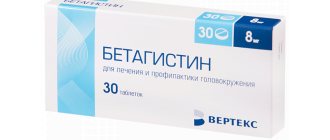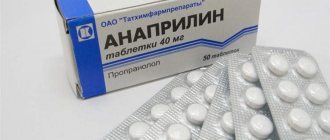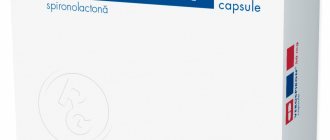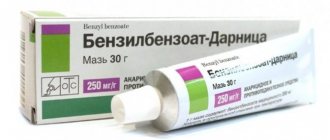Pharmacodynamics and pharmacokinetics
Reduces the flow of calcium into the cell, reduces the level of calcium in the plasmalemma depot, enhances the vasodilatory effect of carbon dioxide, reduces the tone of smooth muscle tissue of arterioles. Cinnarizine has a vasodilating effect and does not affect blood pressure.
The antihistamine activity of the drug is moderate, reduces the tone of the sympathetic nervous system, and moderately reduces the excitability of the vestibular apparatus.
Cinnarizine is effective in patients with a latent variant of cerebral circulatory insufficiency, with the initial form cerebral atherosclerosis a stroke . In persons with impaired peripheral circulation, it improves the nutrition of tissues, organs, myocardium, and increases post-ischemic dilation of the lumen of blood vessels. Cinnarizine reduces blood viscosity, moderately increases the ability of red blood cells to deform, and has a positive effect on the elasticity of their membranes.
Maximum absorption occurs within 1-3 hours. It is excreted in the form of metabolites in the urine by one third and in feces by two thirds. The half-life is 4-24 hours.
Cinnarizine-NAN tablets 25 mg No. 25x2
Name
Cinnarizine-NAN tablet 25 mg in container pack No. 25x2
Description
Tablets are white or almost white, biconvex.
Main active ingredient
Cinnarizine
Release form
Pills
Dosage
25mg
pharmachologic effect
Cinnarizine is a drug from a group of drugs called calcium channel blockers. It helps improve microcirculation. Suppresses nystagmus (uncontrolled eye movements) and other manifestations of vestibular disorders. Has an antihistamine (antiallergic) effect.
Indications for use
Symptomatic treatment of mild and moderately severe dementia for the correction of cognitive and behavioral disorders. Note: before starting treatment, you must make sure that these symptoms are not a manifestation of another disease (for example, a therapeutic, psychiatric or neurological profile) and do not require special treatment.
Use during pregnancy and lactation
Symptomatic treatment of vestibular disorders (Meniere's syndrome of labyrinthine origin, including dizziness, nausea, vomiting, tinnitus, nystagmus). Prevention of kinetosis (sickness when moving). Symptomatic therapy for peripheral circulatory disorders (intermittent claudication syndrome) in adults.
Precautionary measures
Cinnarizine (like other antihistamines) may cause stomach discomfort. Taking the medicine after meals can reduce irritation of the gastric mucosa. Since cinnarizine may cause drowsiness, extreme caution should be used in combination with drugs that have a depressant effect on the central nervous system. In patients with Parkinson's disease, cinnarizine can be prescribed only if the benefits of therapy outweigh the possible risk of worsening the disease. It is necessary to prescribe the drug with caution to patients over 65 years of age, children, as well as patients with a family history or clinical symptoms of extrapyramidal disorders. Cinnarizine should be used with caution in patients with hepatic or renal impairment. In persons prone to hypotension, blood pressure should be monitored during treatment. Due to the presence of an antihistamine effect, cinnarizine can affect the results of anti-doping control of athletes (false-positive results), as well as neutralize positive reactions during skin diagnostic tests (treatment should be discontinued 4 days before the test). Due to the lactose content, the drug should not be prescribed to patients with galactose intolerance, lactase deficiency or glucose-galactose malabsorption. If symptoms persist or worsen while taking the drug, you should consult a doctor. Children. The drug is contraindicated for use in children under 5 years of age due to the lack of sufficient data.
Interaction with other drugs
Concomitant use of alcohol and the use of CNS depressants or tricyclic antidepressants may enhance the sedative effect of any of the listed drugs or Cinnarizine-NAN. Due to the presence of an antihistamine effect, cinnarizine can neutralize positive reactions during skin diagnostic tests (treatment should be discontinued 4 days before the test). If you are taking other medications at the same time, you should consult your doctor.
Contraindications
Hypersensitivity to the active substance or any of the excipients.
Compound
1 tablet contains: active ingredient – cinnarizine – 25 mg; excipients: lactose monohydrate, potato starch, povidone, colloidal anhydrous silicon dioxide, magnesium stearate.
Directions for use and doses
Adults: Diseases of the inner ear: 3 times a day, 1 tablet (75 mg per day). Peripheral circulation disorders: 3 times a day, 2-3 tablets (150-225 mg per day). The duration of the course of treatment is determined by the doctor. Prevention of motion sickness: Adults: 1 tablet (25 mg) half an hour before travel; The dose can be repeated every 6 hours. Children and Adolescents: For children aged 5-12 years, half the adult dose is recommended. Elderly people: no data. Use in liver failure: no data available. Use in renal failure: no data available. Cinnarizine-NAN is preferably taken after meals. The maximum recommended daily dose should not exceed 225 mg (9 tablets). Since the effect of Cinnarizine-NAN on dizziness is dose-dependent, the dose should be increased gradually.
Side effect
Symptoms such as drowsiness and gastrointestinal disturbances may occur. They are usually transient and can be prevented by gradually achieving the optimal dose. In rare cases, headache, dry mouth, weight gain, increased sweating and allergic reactions are observed. In very rare cases, the development of lichen planus and lupus-like symptoms have been reported. A single case of cholestatic jaundice has been reported in the medical literature. Rare cases of worsening or development of extrapyramidal symptoms have been observed primarily in older people during long-term treatment. In such cases, treatment should be stopped. If any adverse reactions occur, including those not listed in this instruction, you should stop using the drug and consult a doctor. Primary Organ System Class (MedDRA 9.1) Adverse Reactions: Immune System Disorders - Adverse Reactions - Hypersensitivity (allergic reactions). Nervous system disorders - Adverse reactions - Drowsiness, Headache, Extrapyramidal disorders. Gastrointestinal disorders - Adverse reactions - Dry mouth Gastrointestinal disorders. Disorders of the liver and biliary tract - Adverse reactions - Cholestatic jaundice. Skin and subcutaneous tissue disorders - Adverse reactions - Hyperhidrosis (excessive sweating), Lichen planus. Musculoskeletal and connective tissue disorders - Adverse reactions - Lupus-like symptoms. Laboratory indicators - Adverse reactions - Increase in body weight.
Storage conditions
In a place protected from light and moisture, at a temperature not exceeding 25? C. Keep out of the reach of children.
Indications for use of Cinnarizine
What are the pills for? The drug is prescribed after an ischemic stroke , after suffering a brain injury, discirculatory encephalopathy , Minière's disease , vestibular disorders, for the prevention of kinetosis .
What other indications for the use of Cinnarizine exist? The medicine is effective for Raynaud's disease , thromboangiitis obliterans , senile dementia, migraine , sea and air sickness, atherosclerosis obliterans , thrombophlebitis , angiopathy , paresthesia , trophic disorders.
What does Cinnarizine help with?
The drug is prescribed for prophylactic and therapeutic purposes for a number of diseases and pathological conditions:
- The recovery period after an ischemic stroke.
- Disculatory encephalopathy.
- Raynaud's syndrome (vasospastic pathology).
- Minière's disease.
- Kinetoses of various origins.
- Condition after suffering traumatic injuries to the head and central nervous system.
- Obliterating atherosclerosis of cerebral vessels.
- Thromboangiitis and thrombophlebitis.
- Sea and mountain sickness.
Any condition accompanied by impaired blood circulation and nutrition of organs can cause the preventive or therapeutic use of Cinnarizine.
Side effects
Nervous system: increased fatigue, drowsiness, extrapyramidal disorders , depression , hyperkinesia , limb tremors, headaches.
Side effects from the digestive system: cholestatic jaundice , dyspeptic disorders, transient epigastric pain, dry mouth.
Rarely increased sweating , allergies , drop in blood pressure, lichen planus , and obesity .
Contraindications, side effects and overdose
The drug has a minimal number of contraindications for use, but they still exist. Cinnarizine is strictly prohibited during pregnancy and breastfeeding. It should also not be prescribed to children under 12 years of age.
A relative contraindication is Parkinson's disease. In this case, Cinnarizine can be used, but under the strict supervision of the attending physician.
Undesirable side reactions develop extremely rarely. Most often they are associated with individual intolerance to the main or auxiliary components of the drug. Some patients may experience weakness, fatigue, headaches, increased drowsiness, nausea, vomiting, stool disorders and dry mouth. It is extremely rare that taking Cinnarizine leads to hypotension and the development of depressive states.
The symptoms of overdose are similar to the manifestations of adverse reactions. If this condition develops, it is recommended to discontinue the drug, thoroughly rinse the stomach with clean water and take adsorbents (activated carbon or filtrum). There is currently no specific antidote.
Cinnarizine tablets, instructions for use (Method and dosage)
The drug is taken orally. There is no injection medicine.
If the blood supply to the brain is impaired: 25-50 milligrams three times a day.
If peripheral blood supply is impaired: 50-75 mg three times a day.
Prevention of sea and airborne illness: 30 minutes before the event, take 25 milligrams.
Labyrinthine disorders: 25 milligrams three times a day.
For children over 12 years of age, the dosage is halved. Age less than 12 years is a contraindication to using the drug.
The effect is achieved with continuous treatment.
Do not take more than 225 mg of medication per day.
Cinnarizine-NAN instructions for use
Cinnarizine-NAN is a drug used to treat dizziness. Cinnarizine is a vasodilator and antihistamine. It dilates small arteries and improves blood flow in peripheral tissues (arms, legs, fingers, etc.) and the brain. Cinnarizine is used for the treatment and prevention of various disorders of cerebral circulation (for example, hypertension with encephalopathy, cerebral atherosclerosis, dementia of vascular origin, after a stroke, traumatic brain injury, etc.) and peripheral circulation (for example, trophic ulcers, numbness in the extremities, obliterating endarteritis, diabetic angiopathy, etc.), as well as kinetosis (motion sickness, etc.). Indications for use: Indications for use of the drug Cinnarizine-NAN are: - Maintenance therapy for symptoms of labyrinthine disorders, which include fainting, tinnitus, nystagmus, nausea and vomiting. — Prevention of motion sickness. — Prevention of migraine. - Maintenance therapy for symptoms of cerebrovascular origin, which include syncope, tinnitus, headache of vascular origin, irritability, memory loss and inability to concentrate. - Maintenance therapy for symptoms of peripheral vascular disorders, which include Raynaud's disease, acrocyanosis, intermittent claudication, trophic disorders, trophic and varicose ulcers, paresthesia, night spasms of the extremities, cold extremities.
Method of administration: For the prevention of sea and air sickness in adults - 25 mg of Cinnarizine-NAN - 1 hour before the upcoming trip, if necessary, repeat the dose in the same dose every 6 hours. For persons especially susceptible to sea and air sickness, it is recommended on the eve of long trips travel (for example, cruises), start taking cinnarizine the day before departure, 25 mg 3 times a day. For vestibular disorders in adults - 25 mg 3 times a day. For peripheral circulatory disorders in adults - 50-75 mg 2-3 times a day. In peripheral arterial disease, the therapeutic effect is achieved slowly, and the maximum effect of cinnarizine is observed after several weeks of continuous treatment, but a significant improvement in blood flow is achieved after 1 week. It is not recommended to exceed the dose of cinnarizine 150 mg per day, the maximum daily dose is 225 mg. In case of high sensitivity to cinnarizine, treatment begins with 1/2 dose, gradually increasing the dose of the drug. To achieve an optimal and long-term therapeutic effect, the drug should be taken continuously for a long time (from several weeks to several months). Dosing in special cases Patients with liver damage: To avoid accumulation, dosage adjustment is recommended in patients with hepatic impairment. Elderly persons: no change in dosage regimen is required. Children and adolescents: for children over 5 years of age, the dose is reduced by 2 times.
Side effects: To assess the frequency of undesirable effects, the following categories are used: very often (≥ 1/10); often (≥ 1/100 and < 1/10); uncommon (≥ 1/1000 and < 1/100); rare (≥ 1/10000 and < 1/1000); very rare (< 1/10000) and the frequency is unknown (the frequency cannot be determined from the available data). Adverse reactions identified in clinical studies: Central nervous system: very common: drowsiness (14.97%), common: headache (2.1%), dizziness (8.3%), uncommon (<1%): lethargy . Gastrointestinal tract: often: general - nausea (1.5%), dry mouth (1.35%), uncommon (<1%): gastrointestinal discomfort, vomiting, abdominal pain, dyspepsia; frequency unknown - cholestatic jaundice. “Common” symptoms: weight gain (2.1%), uncommon (<1%): feeling tired. Diseases of the skin and subcutaneous tissue: uncommon (<1%): increased sweating. Side effects identified in post-marketing studies: Central nervous system: very rarely: dyskinesia, extrapyramidal disorders (limb tremors and increased muscle tone, hypokinesia), parkinsonism; frequency unknown - depression. Diseases of the skin and subcutaneous tissue: very rarely: lichenoid keratosis, lichen planus, lupus-like syndrome. Diseases of the musculoskeletal system, connective tissue and bones: very rare: muscle rigidity. Allergic reactions: frequency unknown - skin rash. Other: frequency unknown - decreased blood pressure.
Contraindications: Contraindications to the use of the drug Cinnarizine-NAN are: hypersensitivity, pregnancy, lactation, children under 5 years of age, extrapyramidal symptoms, Parkinson's disease, history of depression, recent myocardial infarction.
Pregnancy: Despite the fact that no teratogenic effects were found in animal studies of cinnarizine, the use of the drug during pregnancy, like other drugs, can only be justified under conditions where the therapeutic benefits outweigh the possible potential risk to the development of the fetus. There is no information regarding the possibility of cinnarizine passing into breast milk. Therefore, treatment with cinnarizine should be avoided in women during breastfeeding.
Interaction with other drugs: With simultaneous use of Cinnarizine-NAN with tricyclic antidepressants, hypnotics and sedatives, ethanol, ethanol-containing drugs, the (mutually) inhibitory effect on the central nervous system (CNS) is enhanced. When used simultaneously with vasodilators, a mutual enhancement of the effect of cinnarizine and vasodilators is possible.
Overdose : Symptoms of an overdose with Cinnarizine-NAN: vomiting, drowsiness, stupor, tremor, excessive decrease in blood pressure, coma, extrapyramidal symptoms, convulsions (in children). Treatment: there is no specific antidote, gastric lavage in the first hour after an overdose, activated charcoal, symptomatic and supportive therapy.
Storage conditions: Protected from light and moisture, at a temperature not exceeding 25 °C. Keep out of the reach of children.
Release form: Cinnarizine-NAN - tablets, 25 mg. 25 tablets in a blister pack. 1 or 2 contour packages along with instructions for medical use in a cardboard pack.
Composition: 1 tablet of Cinnarizine-NAN contains: active ingredient – cinnarizine – 25 mg; excipients: lactose monohydrate, potato starch, povidone, colloidal anhydrous silicon dioxide, magnesium stearate.
Additionally: Due to the lactose content of monohydrate, patients with rare congenital galactose intolerance, Lapp lactase deficiency or glucose-galactose malabsorption are not recommended to take this drug. Due to the presence of an antihistamine effect, cinnarizine can affect the results of anti-doping control of athletes (false-positive results), as well as neutralize positive reactions during skin diagnostic tests (treatment should be discontinued 4 days before the test). Caution should be exercised when prescribing cinnarizine to patients with severe hypotension. With long-term use, it is recommended to conduct a control examination of liver function, kidney function, and peripheral blood patterns. Women taking cinnarizine are not recommended to breastfeed. Like other antihistamines, cinnarizine can cause pain in the epigastric region; in order to reduce their severity, it is recommended to take the drug after meals. Cinnarizine should be avoided in patients with porphyria. Impact on the ability to drive a car and potentially dangerous mechanisms During the treatment period, care must be taken when driving vehicles and engaging in other potentially dangerous activities that require increased concentration and speed of psychomotor reactions. Especially at the beginning of treatment, drowsiness, decreased reaction speed and level of attention may occur. Cinnarizine (which has a depressant effect on the central nervous system) should be used with extreme caution simultaneously with alcohol or anesthesia. Patients suffering from Parkinson's disease should be prescribed cinnarizine only in cases where the benefits of its use outweigh the possible risk of worsening the condition. It is necessary to monitor the occurrence of extrapyramidal symptoms and depression in elderly patients taking cinnarizine; if necessary, the drug should be discontinued and appropriate therapy prescribed. Children aged 5 to 12 years are recommended to take half the dose recommended for adults.
special instructions
Cinnarizine may cause false positive doping tests in athletes. This effect is explained by the antihistamine effect of the drug. Long-term use requires monitoring the functioning of the liver, kidneys, and blood condition. It is acceptable to take the drug while breastfeeding. Affects transport management.
A combination of Cinnarizine and Piracetam for chronic cerebrovascular insufficiency. The interaction of these substances is described in detail on Wikipedia.
Cinnarizine analogs
Level 4 ATX code matches: Betagis
Stugeron
Betaserk
Betaver
Westinorm
Westicap
Betagistine
Tagista
Vestibo
An analogue of the drug is Stugeron .
Cinnarizine price, where to buy
The price of Cinnarizine tablets is about 60 rubles for 50 pieces.
- Online pharmacies in RussiaRussia
- Online pharmacies in UkraineUkraine
- Online pharmacies in KazakhstanKazakhstan
ZdravCity
- Cinnarizine tablets 25 mg 50 pcs. Pharma AD
58 rub. order - Cinnarizine tablets 25 mg 50 pcs. Sopharma AD
83 RUR order
- Cinnarizine tablets 25mg 56pcs AO Update PFC
101 rub. order
- Cinnarizine tablets 25 mg 50 pcs. OzonOzon LLC
65 rub. order
- Cinnarizine Avexima tablets 25 mg 50 pcs. LLC Avexima Siberia
68 RUR order
Pharmacy Dialogue
- Cinnarizine (tab. No. 50)Pharma AD
65 rub. order
- Cinnarizine (tab. No. 50)Sopharma
69 RUR order
- Cinnarizine (tab. No. 50)Pharma AD
68 RUR order
- Cinnarizine (tab. No. 56)Update of PFC CJSC
94 RUR order
show more
Pharmacy24
- Cinnarizine 25 mg N50 tablets AT "Lekhim-Kharkiv", Ukraine
13 UAH.order - Cinnarizine-KMP forte 75 mg N20 tablets PAT "Kievmedpreparat", Ukraine
33 UAH order
- Cinnarizine Sopharma 25 mg N50 tablets PAT "Vitamin" Ukraine
19 UAH order
PaniPharmacy
- Cinnarizine tablets Cinnarizine tablets. 25mg No. 50 Ukraine, Lekhim-Kharkov CJSC
12 UAH order
- Cinnarizine forte tablets Cinnarizine forte tablets. 75 mg No. 20 Ukraine, Kievmedpreparat OJSC
39 UAH order
- Cinnarizine tablets Cinnarizine tablets. 25 mg No. 50 Bulgaria, Sopharma
23 UAH order
show more




